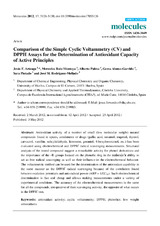Comparison of the Simple Cyclic Voltammetry (CV) and DPPH Assays for the Determination of Antioxidant Capacity of Active Principles
Autor
Arteaga, Jesús F.
Ruiz Montoya, Mercedes
Palma, Alberto
Alonso-Garrido, Gema
Pintado Benzal, Sara
Rodríguez-Mellado, J. Miguel
Editor
MDPIFecha
2012Materia
Antioxidant activityCyclic voltammetry
DPPH
Phenolics
Low weight antioxidants
METS:
Mostrar el registro METSPREMIS:
Mostrar el registro PREMISMetadatos
Mostrar el registro completo del ítemResumen
Antioxidant activity of a number of small (low molecular weight) natural compounds found in spices, condiments or drugs (gallic acid, sesamol, eugenol, thymol, carvacrol, vanillin, salicylaldehyde, limonene, geraniol, 4-hexylresorcinol, etc.) has been evaluated using electrochemical and DPPH• radical scavenging measurements. Structural analysis of the tested compound suggest a remarkable activity for phenol derivatives and the importance of the –R groups located on the phenolic ring in the molecule’s ability to act as free radical scavenging as well as their influence in the electrochemical behavior. The voltammetric method can be used for the determination of the antioxidant capability in the same manner as the DPPH• radical scavenging because of the correlation found between oxidation potentials and anti-radical power (ARP = 1/EC50). Such electrochemical determination is fast and cheap and allows making measurements under a variety of experimental conditions. The accuracy of the electrochemical measurements is the same for all the compounds, irrespective of their scavenging activity, the opposite of what occurs in the DPPH• test.

